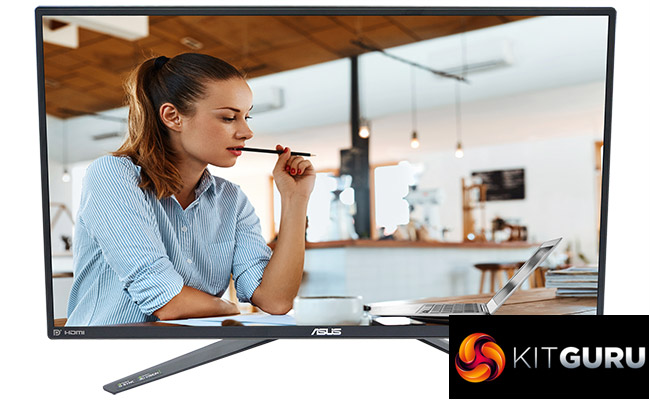The ASUS ROG SWIFT PG258Q is definitely a cut above a regular TN gaming display. The only slight quality niggle is the gamut, which is a little below par, but otherwise our analysis showed an extremely capable screen, with excellent brightness and colour uniformity, decent colour accuracy uncalibrated, and brilliant accuracy when calibrated.
Throw in the incredible 240Hz refresh allied with G-Sync, and NVIDIA users will be able to enjoy pin-sharp, motion-blur-free gaming at any frame rate, with the TN panel's 1ms response ensuring minimum reaction times – or even better if you overdrive the screen. Then there are the added extras of built-in crosshairs, FPS monitoring, and Dark Boost to give you some assistance in gloomy FPS levels.
You do pay a small fortune for this 24.5in Full HD screen, but if you're looking for every gaming edge you can get and are willing to pay for it, there are few better screens than this. Currently, in fact, there are no screens offering more than 240Hz refresh.
ASUS knows it's got one of the best 24in-class gaming screens available here, and unfortunately you will have to open your wallet for that. Or, for £150 less, the ASUS ROG SWIFT PG258Q will perform almost as well with 180Hz refresh. But you always have to pay for the best current technology.
The ASUS ROG SWIFT PG258Q is available on Scan.co.uk.
Discuss on our Facebook page, over HERE.
Pros:
- Incredible 240Hz refresh.
- NVIDIA G-Sync.
- Great colour fidelity for TN.
- Good brightness and colour uniformity.
- Healthy selection of gaming adjustments.
Cons:
- Expensive.
- Slightly disappointing gamut.
- Only two downstream ports on USB hub.
- Only two video inputs.
Kitguru Says: The ASUS ROG SWIFT PG258Q boasts a humongous 240Hz refresh and NVIDIA G-Sync, allied with plenty of gaming features and excellent image quality, making this a top-end gaming choice – if you can afford it.
 KitGuru KitGuru.net – Tech News | Hardware News | Hardware Reviews | IOS | Mobile | Gaming | Graphics Cards
KitGuru KitGuru.net – Tech News | Hardware News | Hardware Reviews | IOS | Mobile | Gaming | Graphics Cards





I’ll give this review 6 out of 10.
1) I cannot enlarge the images (using google chrome)
2) You never once mention anything about backlight bleeding.
3) It could be because the images cannot be enlarged I dont know. But how deep of a black color level can it produce?
Thanks for highlighting the issue with the images. I have fixed them.
Does 240 Hz make a huge difference compared to 144 Hz? I’m only at 75 Hz but I can tell a noticeable difference in that and 60 Hz when playing Battlerite.
Backlight bleeding is typically an issue on IPS and VA panels, not TN like this monitor.
backlight bleeding is very much a problem with TN. I’ve had my fair share of TN panels, all with backlight bleeding. Two BenQ XL2411Z and two Asus VG248QE.
I know it can happen on TN. My point is that it occurs much more frequently on IPS/VA. Out of the dozen or so TN monitors I have had over the years (and I have two right now), I’ve only had any backlight bleeding on one of them. Conversely I’ve had to RMA 3 or 4 IPS monitors just for that issue and it is much more pronounced and prevalent on IPS monitors. TN is the exception -yes it happens, just not as much. It’s not an argument whether or not backlight bleeding is bad. Because it sucks.
<- Finally! There is a great way how you can work online from your home using your computer and earn in the same time… Only basic internet knowledge needed and fast internet connection… Earn as much as $3000 a week………….how you can do it yourself. ➤➤➤➤ www,HighPayCyberWork,com
Not at all. I have used both, and anything beyond 120 is unnoticeable. At least to me. Maybe for the hard core CS:GO guys it’s useful, but for frame lag, not for visual smoothness.
Gsync +144 is all you really notice.
Backlight bleed is an inherent flaw with backlit LCD technologies and it will happen to some degree regardless of the panel type, which actually doesn’t influence it at all. I assume you’re mixing it up with IPS glow, which is actually a different issue.
No review seems to explain whether or not the lighting produced by the monitor stand can be turned off.
This other “hands on” review even decides to bash anyone that would want to turn off the lighting instead of explaining whether or not it can be turned off (end of the review): http://www.techradar.com/reviews/pc-mac/monitors-and-projectors/monitors/asus-rog-swift-pg258q-1327880/review
Unless the monitor is on a shelf in a shop or I want to show off to friends or something I don’t see why I would want to distract myself with light sources around the display. I similarly do not understand TV’s that feature chrome/reflective TV Stands. Why would I want to be distracted from what I am trying to watch??
I took a leap of faith and upgraded from 144 to 240. I gotta say, you
don’t feel the difference in the same way as when you go 60 to 144 you
feel it when you go back to 144 from 240. So its more subtle but
definitely would consider it, especially if you need an upgrade. Was
looking at this ASUS but the price was beyond my budget. Settled with
this ViewSonic one instead
http://www.viewsoniceurope.com/gaming/products/XG2530.php